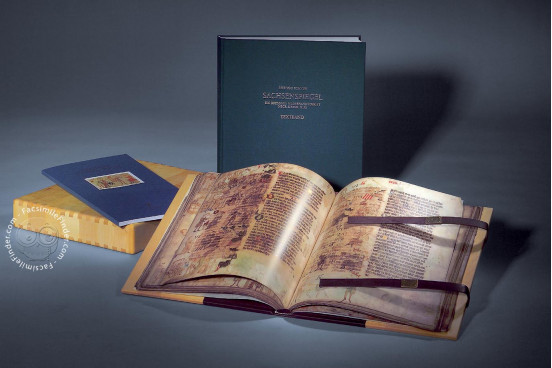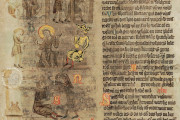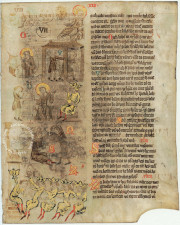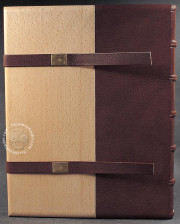The Dresden Mirror of Saxony, which takes its name from the place where it is preserved, is the most significant collection of legal texts to have reached us from the Middle Ages. The most opulent codex of its type, it is lavishly decorated in gold and endowed with an incredible number of depictions.
With its 924 miniatures on 92 leaves (size 33 x 26 cm), showing the basics of the German legal system in the Middle Ages, the Dresden Mirror of Saxony is both an incredible artifact and an unparalleled mirror of German Medieval culture: more than 4,000 different characters are showed in the illuminations, together with domestic tools, vestments and so forth, making this manuscript an essential source for historians of Medieval civilization.
The Dresden Mirror of Saxony: Gold in Each Folio
Unfortunately, the artists who took part in the decoration of this manuscript remain unknown; however, they were undoubtedly masters during their time, something witnessed by the incredible quality of the book's miniatures. Another awe-inspiring feature of the Dresden Mirror of Saxony is the manuscript's exuberant wealth of decoration: every single folio of the codex bears opulent gold insertions.
Illuminations that Fit the Text Perfectly
The 924 picture strips, about four and eight per page that flank the text on the right side, are used as a means of explaining the text itself. However, numerous initials, majuscule and enlarged letters subdivide the columns. Some of them, in gold and bright colors, link to the text in perfect harmony.
Was the Book Commissioned by Margrave Frederick of Meissen
Probably crafted between 1347 and 1363, the Dresden Mirror of Saxony was likely produced in Meissen. At the time, this town was the 'headquarters' of the Upper Saxony Margraves. Among them was Margrave Frederick III (1349–1381) whose principal concern was that of bettering the administration and codifying customary law; scholars now think it was probably he who commissioned the book.
Eike von Repgow and the Codification of Customary Law
Born around 1180 near Dessau, Eike von Repkow was an official court witness and adviser to several noblemen. When civil war broke out, particularly between the Guelfs and the Hohenstaufen dynasty, von Repkow decided to devise a secure system of laws. Between 1220 and 1235, he was behind the codification of a stable and precise customary law code that would stand the test of time.
An Extremely Popular Legal Treatise
Eike von Repkow’s text, which soon came to be known as the “Mirror of Saxony”, was extremely popular: more than 400 manuscripts or fragments of it survive, something that witnesses how important this text was. The Mirror contains detailed information about the legal status of various groups of people and social classes: sovereigns and knights, peasants and the clergy.
The Two Parts: Landrecht and Lehnrecht
The Mirror of Saxony has two sections: the so-called Landrecht, or territorial law, and the Lehnrecht, or feudal law. The prologue recounts the close relationship between God and mankind, warning all of the kingdom's subjects to abide by the regulations allegedly decreed by Roman emperor Constantine (307–377) and Charlemagne (768–814). The Landrecht deals with all the issues arising from the possession of land, succession rights and legal regulations regarding marriage; it also includes penal and constitutional laws, that is criminal and civil procedures. The feudal regulations, on the other hand, pinpoint the hierarchic order of the Middle Ages.
"Environmental Law" and "Road Traffic Regulations"
The popularity of the Dresden Mirror of Saxony is also witnessed by its extremely down-to-earth character. Several laws contained in it are even still in force today, or have been the basis for current regulations. One important rule was that concerning life in the country. The villages' narrow passages called for the right of way should two carts met at a cross-roads. Since a lightweight vehicle is less impeded to make way, the laws stated that empty carriages would have to give way to loaded ones, but also pedestrians to persons on horseback. Other regulations set the distance that must be kept from the oven since it is dangerous, but also discipline the distance of lavatories and pigsties from the village to avoid odor: environmental awareness was already present in the Middle Ages.
We have 1 facsimile edition of the manuscript "Dresden Mirror of Saxony": Der Dresdner Sachsenspiegel facsimile edition, published by Akademische Druck- u. Verlagsanstalt (ADEVA), 2002
Request Info / Price




